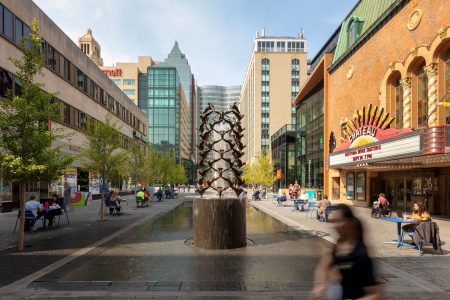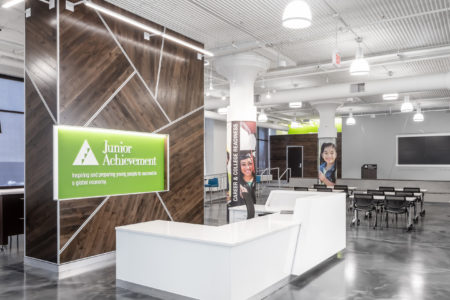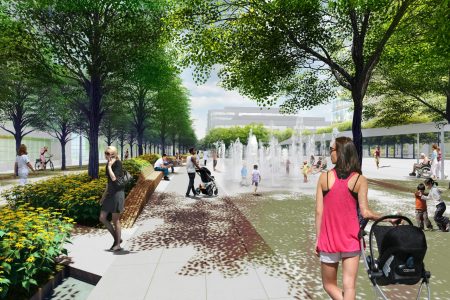Future City Meets Heart of the City
Architect, astronaut, fire prevention engineer, anesthesiologist, Air Force pilot, seismologist. And these were just some of their career aspirations. The future is bright for St. Francis of Assisi’s Future City team members. Which is exactly why the Heart of the City Design team was interested in hearing their ideas.
When George Brophy, RSP Architect’s business developer shared the Future City story with his colleague Jon Buggy, he immediately wanted to meet with the students.
“Our work in the Heart of the City and Discovery Square is about the future of the City of Rochester. And these kids are the future of the City.”
Jon Buggy, RSP Principal
Within a week, the students, their parents and teachers were in RSP’s office in Rochester, along with members of the Heart of the City Design Team, signaling the importance of this meeting on all sides.
The Future City team arrived with excitement, anxious to take the design team through their process. As we went through introductions, the kids learned that Dan Coyle, civil engineer with Kimley-Horn and member of the Heart of the City Design Team, served as a judge for the competition at the Minnesota State Level.
Through the guidance of Dennis Schreiber, teacher advocate, and team mentor Eileen Kennedy-Warrington, who happens to hold a degree in Physics, the contestants described the process they worked through from early October to late November.
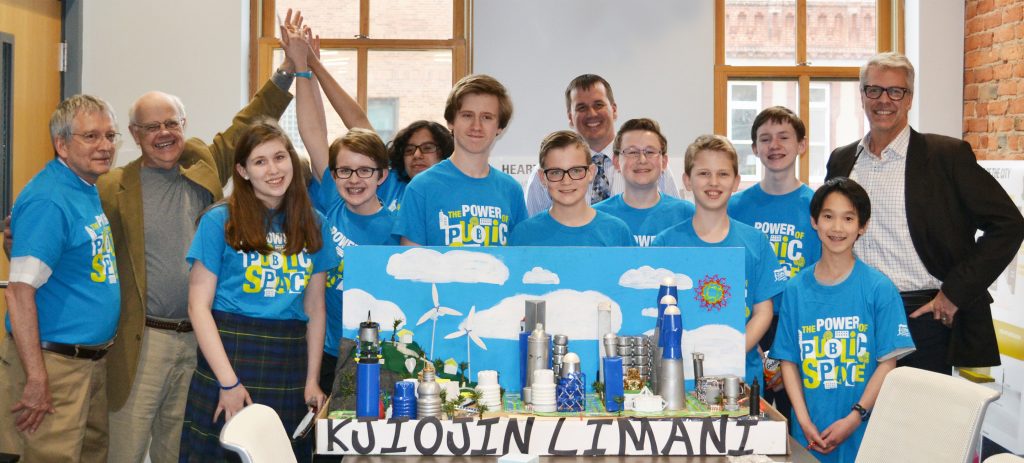
understanding the Project
The Future City competition is designed to expose middle school students to engineering in a creative, hands-on way. The project started with an online simulation that required the team to create a city with a population of roughly 8,000 – 20,000. The project goals:
- City is happy, healthy city to work in with less than 10% sick or injured
- Plenty of parks, within walking distance
- Public transit is available to all
- Wait times at bus stops and train stations are no longer than 20 minutes
Early in the project, the team melded as a group. Age, social status, title, popularity didn’t matter. 8th graders learned from 7th graders and vice versa. “The whole popularity cliques of junior high melted away. We are one in Future City,” said one of the students.
The next phase of the program was the project plan, which was a recent addition to the competition and one of the biggest learning experiences for the kids. They leveraged resources including mentors, teachers and the Future City website and handbook. They identified constraints, helping them understand the barriers that could stand in the way of their project, including time, budget, limited supplies and team member availability.
THE PROJECT TEAM SETTLED ON TWO MAIN GOALS
The first was to complete every deliverable a week in advance. Though they had mixed reviews on the achievement of this goal, students used Google Classroom to work real time with one another. One student even logged on from home while sick to meet a deadline.
Their second goal was to stay open-minded and keep arguing at a minimum. Their largest argument was deciding between selecting Mars or Fiji as the inspiration for their future city. After slideshows, convincing “logic battles” and deep discussions, the team found common ground from an unlikely source: trade routes. This is how they selected KJIOJIN LIMANI, a city off the coast of Crete. One of the team members said, “ If you are having a disagreement, sometimes it’s easier to just drop both ideas and come up with something completely different together.” KJIOJIN LIMANI was chosen and they were on their way!
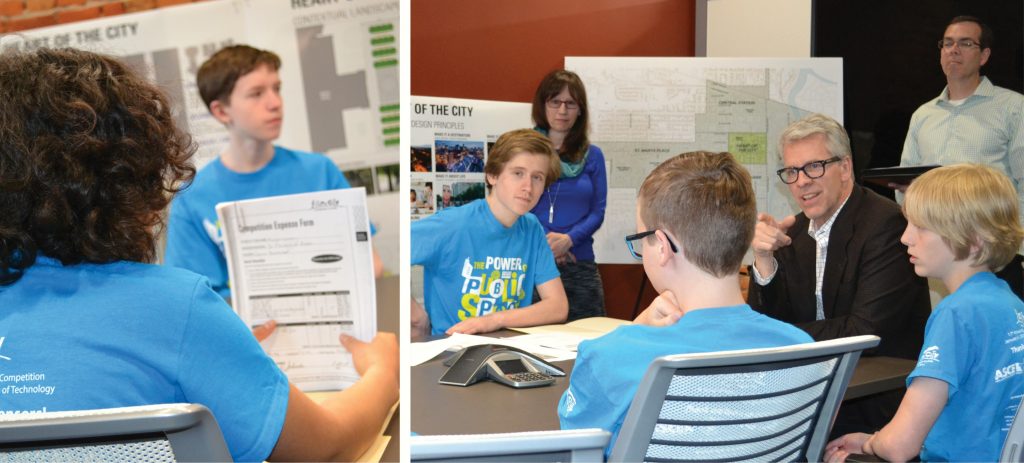
Project Results
The team was required to write an essay, build a model and deliver a seven-minute presentation on their city, keeping public space design as a central theme. Here are their ideas:
EMBRACING HISTORY Made from an ancient, but still used stone roadway, Stone Path Park included a fully pedestrian zone and public space. Olympic structures along the sides of the road were transformed into municipal buildings including a museum, art gallery, library and school for students to learn about and connect with the city’s ancient history.
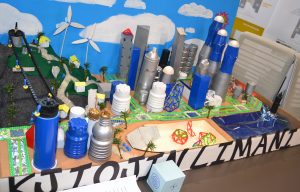
They restored road surfaces and buildings using the same materials as existing buildings while upgrading their interiors. They relied on the test, improve and redesign steps of the engineering process to move their projects forward. Traffic was diverted and new patterns developed using LED light signals to redirect traffic around the park. Nearby, rapid transit and an accessible gondola brought visitors to and from the space. The art gallery show-cased an interactive sculpture titled Global Heart featuring the world in the shape of a heart, symbolizing love and equality for all. Visitors could sign their names on the base.
BROWNFIELD CONVERSION Their second public space required a brownfield conversion of heavily contaminated dry-docks. The area was decontaminated and transformed into spaces that everyone can use and enjoy. The team studied specifications to choose the most effective remediation methods that wouldn’t harm wildlife. Their design included converting a large dock into an ancient Greek amphitheater featuring a performing arts stage on one end and a drone racing track at another. A smaller dock featured a hoverboard park. The team also incorporated a desalination plant to service the increased need for clean drinking water resulting from projected population growth.
Even though their hypothetical city had its challenges, the team focused their design on placemaking to improve the planning, design and management of public spaces. They wanted to improve the quality of life for their residents. Each space was designed to bring people together, increase physical activity and become a central point for residents and tourists. Naturally, the city featured a partnership with The Mayo Clinic to provide access to excellent healthcare.
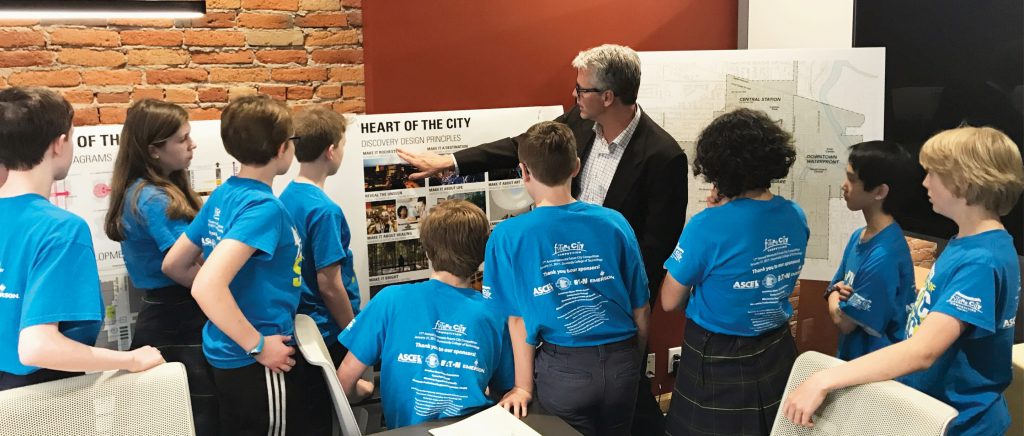
HARD WORK YIELDS RESULTS AND IDEAS
The hard work and long hours has certainly paid off for the team. Saint Francis of Assisi represented the State of Minnesota at the National Future City Competition. The Heart of the City Design Team was amazed with the achievements and knowledge of the students and were even more excited to hear their ideas for the future of Rochester. When the conversation shifted, one student called out “This is what we came for!” Another said, “We can tell our grandchildren about this!”
The students were especially interested in more green spaces utilizing areas both underground and high on top of buildings. One idea included underground botanical gardens tunneling sunlight indoors, providing a much-needed respite from tough Minnesota winters. Another idea was putting more parks on top of buildings allowing residents and visitors to enjoy green spaces from another vantage point.

Students were also interested in strengthening the connection to the Zumbro River. They realized the need for the flood prevention walls on either side of the river, but wondered if there was a way to green up the space by creating decorative shelves layered in plant-life. One student thought there should be more public spaces near the river where people can hang out and enjoy it.
And just like KJIOJIN LIMANI, they also suggested a hoverboard park.
This was the 11th consecutive year St. Francis of Assisi and Dennis Schreiber have been involved in the Future City Competition, and the second year that Eileen Kennedy-Warrington has mentored. Countless volunteers have kept this program going strong at St. Francis and for good reason. At least 6 students have entered careers in either architecture or engineering.

